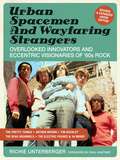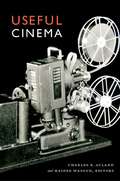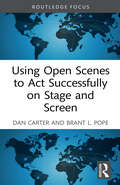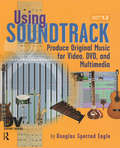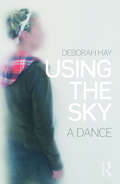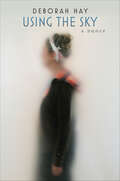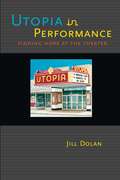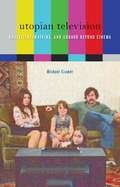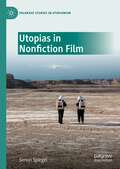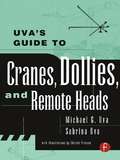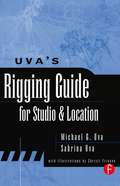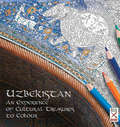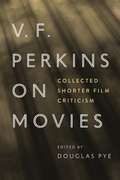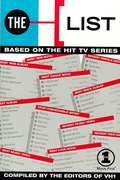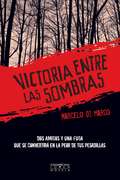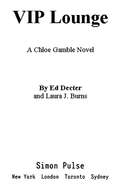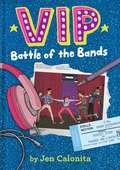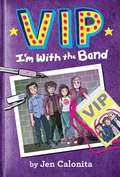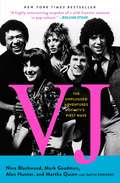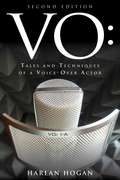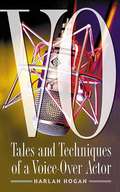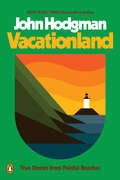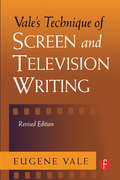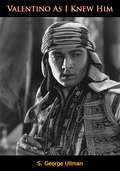- Table View
- List View
Urban Spacemen and Wayfaring Strangers
by Richie Unterberger"Urban Spacemen & Wayfaring Strangers: Overlooked Innovators & Eccentric Visionaries of '60s Rock" documents twenty cult rockers from the 1960s. The book features extremely detailed investigation of the careers of greats like the Pretty Things, Arthur Brown, Richard & Mimi Fariña, and Tim Buckley. Also featured are the Bonzo Dog Band, the Electric Prunes, Bobby Fuller, the Fugs, Kaleidoscope, Fred Neil, the Beau Brummels, Thee Midniters, Dino Valenti, Mike Brown of the Left Banke, and others, including producers Shel Talmy (the Who, the Kinks, Pentangle) and Giorgio Gomelsky (the Yardbirds, Julie Driscoll, the Soft Machine). In all cases, the extensive chapters include first-hand interview material with the artists themselves and/or their close associates. Lost British Invaders, psychedelic pioneers, rock funnymen, blue-eyed soulsters, overlooked folk-rockers, behind-the-scenes producers -- all find a home as part of "Urban Spacemen & Wayfaring Strangers," with a foreword by Paul Kantner of Jefferson Airplane. The ebook version of "Urban Spacemen & Wayfaring Strangers" is significantly expanded, revised, and updated from the print version, adding 20,000 words of new material. The text is accompanied by illustrations and reviews of the most essential recordings by each artist. From reviews of "Urban Spacemen":"[He] brings to this volume a true fan's love of music combined with a writer's smarts and skills. He seamlessly combines researched material with new interviews. . . Not only did Unterberger choose well musically, but he found the momentum and heart of each of their stories. " -- David Greenberger (essayist on National Public Radio's "All Things Considered"), Pulse!"These fascinating tales will make you want to rush out to the record store -- a hallmark of all great music writing. " -- Jim DeRogatis, Chicago Sun-Times"In each fascinating case study the author tracks down one or more former group members and/or principals in the story, which gives his work both authority and freshness. . . his overall handling of the material is exemplary. "Urban Spacemen" forms a compelling mosaic of the hopes and dreams -- not to mention sharp business practices -- of the decade. " -- Mike Barnes (author of the biography "Captain Beefheart"), The Wire
Useful Cinema
by Haidee Wasson Charles R. AclandBy exploring the use of film in mid-twentieth-century institutions, including libraries, museums, classrooms, and professional organizations, the essays in Useful Cinema show how moving images became an ordinary feature of American life. In venues such as factories and community halls, people encountered industrial, educational, training, advertising, and other types of "useful cinema." Screening these films transformed unlikely spaces, conveyed ideas, and produced subjects in the service of public and private aims. Such functional motion pictures helped to shape common sense about cinema's place in contemporary life. Whether measured in terms of the number of films shown, the size of audiences, or the economic activity generated, the "non-theatrical sector" was a substantial and enduring parallel to the more spectacular realm of commercial film. In Useful Cinema, scholars examine organizations such as UNESCO, the YMCA, the Amateur Cinema League, and the Metropolitan Museum of Art. They also consider film exhibition sites in schools, businesses, and industries. As they expand understanding of this other American cinema, the contributors challenge preconceived notions about what cinema is. Contributors. Charles R. Acland, Joseph Clark, Zoë Druick, Ronald Walter Greene, Alison Griffiths, Stephen Groening, Jennifer Horne, Kirsten Ostherr, Eric Smoodin, Charles Tepperman, Gregory A. Waller, Haidee Wasson. Michael Zryd
Using Open Scenes to Act Successfully on Stage and Screen
by Dan Carter Brant L. PopeUsing Open Scenes as a "way in" to scripted material, this book establishes a foundational actor training methodology that can be applied to the performance of film or television acting, commercials, and theatrical realism. Unlike other methodologies, this unique approach is devoid of casting considerations or imposed identity, providing actors opportunities that do not rely on nor are restricted by age, gender, race, ethnicity, regional accent, body type, identity, or other defining or delimiting aspects that come into play during the casting process. This allows the actor to focus on personal authenticity as they develop their skills. This book will appeal to undergraduate students, acting teachers, and the contemporary actor seeking a career in film, television, or other electronic media. Visit the companion website www.usingopenscenestoactsuccessful.godaddysites.com for additional Open Scenes and more.
Using Soundtrack: Produce Original Music for Video, DVD, and Multimedia (Dv Expert Ser.)
by Douglas Spotted EagleCovering the basics of producing great audio tracks to accompany video projects, Using Soundtrack provides recording and editing tips and guidance on noise reduction tools, audio effects, and Final Cut Pro's powerful real-time audio mixer. Readers also learn how Soundtrack can be used to give video projects a professional finish with the addition of custom, royalty-free scoring. Theory is presented on a need-to-know basis and practical tutorials provide hands-on techniques for common tasks, including editing video to audio, editing audio to video, changing the length of a music bed, editing dialog, and mixing dialog with music and sound effects. The accompanying CDROM includes tutorial lessons and sample media.
Using the Sky: A Dance
by Deborah HayIn the mid 1990’s Deborah Hay’s work took a new turn. From her early experiments with untrained dancers, and after a decade of focusing on solo work, the choreographer began to explore new grounds of choreographic notation and transmission by working with experienced performers and choreographers. Using the Sky: a dance follows a similar path as Hay’s previous books—Lamb at the Altar and My Body the Buddhist—by exploring her unrelenting quest for ways to both define and rethink her choreographic imagery through a broad range of alternately intimate, descriptive, poetic, analytical and often playful engagement with language and writing. This book is a reflection on the experiments that Hay set up for herself and her collaborators, and the ideas she discovered while choreographing four dances, If I Sing to You (2008), No Time to Fly (2010), A Lecture on the Performance of Beauty (2003), and the solo My Choreographed Body (2014). The works are revisited by unfolding a trove of notes and journal entries, resulting in a dance score in its own right, and providing an insight into Hay’s extensive legacy and her profound influence on the current conversations in contemporary performance arts.
Using the Sky: A Dance
by Deborah HayDeborah Hay is an internationally renowned dance artist whose unique approach to bodily practice has had lasting impact on American choreography. Her commitment to dance as a process is as exquisite as it is provoking. Rooted in NYC's 1960s experimental Judson Dance Theater in New York, Hay's work has evolved through experimentation with a use of language that is unique to dance. This book is an exploration and articulation of Hay's process, focusing on several of her most recent works.
Utopia in Performance
by Jill DolanLive performance can provide people with inspiration for an improved world, Dolan argues, one that seems to be slipping further away since 9/11. As examples, she analyzes autobiographical performances by feminists Holly Hughes, Peggy Shaw, and Deb Margolin; multiple- character monologues by Lily Tomlin, Danny Hoch, and Anna Deavere Smith; the political suggestions of Russell Simmons Def Poetry Jam on Broadway and The Laramie Project; and radical humanism in Ann Carlson's Blanket, Mary Zimmerman's Metamorphoses, and Deborah Warner and Fiona Shaw's Medea. Annotation ©2006 Book News, Inc. , Portland, OR (booknews. com)
Utopian Television: Rossellini, Watkins, and Godard beyond Cinema
by Michael CramerTelevision has long been a symbol of social and cultural decay, yet many in postwar Europe saw it as the medium with the greatest potential to help build a new society and create a new form of audiovisual art. Utopian Television examines works of the great filmmakers Roberto Rossellini, Peter Watkins, and Jean-Luc Godard, all of whom looked to television as a promising new medium even while remaining critical of its existing practices.Utopian Television illustrates how each director imagined television&’s improved or &“utopian&” version by drawing on elements that had come to characterize it by the early 1960s. Taking advantage of the public service model of Western European broadcasting, each used television to realize works that would never have been viable in the commercial cinema. All three directors likewise seized on television&’s supposed affinity for information and its status as a &“useful&” medium, but attempted to join this utility with aesthetic experimentation, suggesting new ways to conceive of the relationship between aesthetics and information.As beautifully written as it is theoretically rigorous, Utopian Television turns to the writing of Fredric Jameson and Ernst Bloch in treating the three directors&’ television experiments as enactments of &“utopia as method.&” In doing so it reveals the extent to which the medium inspired and shaped hopes not only of a better future but of better moving image art as well.
Utopias in Nonfiction Film (Palgrave Studies in Utopianism)
by Simon Spiegel'Comprehensive and thorough, Utopias in Nonfiction Film takes a new direction in its surprise application to documentary that has the potential to shake up the field.'- Jane Gaines, Columbia University, USA'Spiegel has introduced a new sub-genre to utopian studies, the documentary film. The book covers an impressive range of films, making the book one of the few truly international and comparative works in utopian studies.'- Lyman Tower Sargent, University of Missouri-St. Louis, USA"Simon Spiegel’s magisterial overview of utopian documentaries and nonfiction films is a treasure trove of information and unearths many forgotten and half-forgotten films, providing perceptive discussions of sidelined movies that deserve his (and our) critical scrutiny.“ - Eckart Voigts, University of Braunschweig – Institute of Technology, GermanyThis book is the first major study on utopias in nonfiction film. Since the publication of Thomas More’s Utopia more than 500 years ago, countless books have been written which describe a better world. But in film, positive utopias seem to be nonexistent. So far, research has focused almost exclusively on dystopias, since positive outlooks seem to run contrary to the media’s requirement. Utopias in Nonfiction Film takes a new approach; starting from the insight that literary utopias are first and foremost meant as a reaction to the ills of the present and not as entertaining stories, it looks at documentary and propaganda films, an area which so far has been completely ignored by research. Combining insights from documentary research and utopian studies, a vast and very diverse corpus of films is analysed. Among them are Zionist propaganda films, cinematic city utopias, socialist films of the future as well as web videos produced by the Islamist terrorist group ISIS.
Uva's Guide To Cranes, Dollies, and Remote Heads
by Michael Uva Sabrina UvaUva's Guide To Cranes, Dollies, and Remote Heads is a comprehensive guide to all the latest equipment-what it is, how to use it and where to find it. This new book is designed to provide the more experienced professional with a streamlined reference to the equipment without the how-to information beginners require. Like the Grip Book 2E, it lists standards and features of all the different types of equipment covered, and with the recent explosion of new equipment introduced into the film industry this reference is invaluable!As a reference guide, Uva's Guide To Cranes, Dollies and remote heads provides must-have information for a larger group of film professionals. Producers, directors, and DPs, and others responsible for securing equipment for a project will consider this an indispensable tool that will become an industry standard.
Uva's Rigging Guide for Studio and Location
by Michael Uva Sabrina UvaReaders of Mike Uva's GRIP BOOK who are interested in more detailed information on the work of the grip department will welcome his new rigging manual, clearly detailing all the ways to mount cameras and lights both on a set as well as on location. The book covers the latest truss systems, rigging equipment and portable stages, as well as lifts, boom arms and camera mounts for every type of moving vehicle. The book is not limited to equipment specifications, however; Uva offers tips and tricks throughout in order to make the process of setting up and shooting safer and more efficient. Grips often need to invent makeshift solutions in a short time, and Uva shares many such devices developed over his years in the film and TV industry. This book will help grips and key grips move on to the bigger feature projects and commercials that require this equipment. It will also be useful for directors of photography and producers in pre-planning the required equipment for specific shots.
Uzbekistan: An Experience of Cultural Treasures to Colour
by Lola Karimova-TillyaevaFollow the Silk Road—and color! &“A joy . . . a beautiful book about the arts, craft, and architecture of Uzbekistan.&” —Olga Núñez Miret, author of the Angelic Business series Like the fascinating culture that comes to life between its pages, Uzbekistan: An Experience of Cultural Treasures to Color will take you on a journey of discovery from the blue and gold splendors of Samarkand to the intricacy of sacred mosaics. It&’s the perfect way for you and your children to explore Uzbekistan&’s rich cultural heritage, taking us along the Silk Road from fifth century architecture to modern-day artists. As we turn the pages, exquisite full-color photographs transport us to some of the world&’s most magnificent architectural monuments. From palaces through mosques, madrasahs and mausoleums, we wend our way amongst masterpieces of Islamic architecture, marveling at the captivating mosaics with their complex geometric patterns or motifs inspired by the world of plants and mythological beasts. Fascinating and vibrant, they testify to the skill and craftsmanship of historic Uzbek masters. As a tribute to this rich heritage, Uzbekistan: An Experience of Cultural Treasures to Color is a celebration of the arts and pictorial traditions of this fascinating land. Photographs of architectural monuments, murals, ceramics, tapestries and ornamented textiles highlight the country&’s cultural treasures. Short accompanying texts explain their historical significance. On the right-hand page, the reader is given the opportunity to color in drawings based on the beautiful photographs provided. &“A gorgeous book for grownups who want to get their coloring on.&” —Cayocosta 72
V. F. Perkins on Movies: Collected Shorter Film Criticism (Contemporary Approaches to Film and Media Series)
by George M. WilsonVictor Perkins (1936–2016) was a foundational figure for the study of film both as a writer and as an educationalist and teacher who played a key role in establishing film within British higher education. Best known for his 1972 book Film as Film, Perkins has a worldwide reputation within film studies that has been enhanced in recent years by the interest among emerging scholars in the practices of detailed film criticism. His extensive writing in journals and edited collections, spanning sixty years, is less well known, despite its importance and quality, partly because much of it was published in small magazines with limited distribution. V. F. Perkins on Movies: Collected Shorter Film Criticism, edited by Douglas Pye, makes it possible to see his writing as a coherent body of work, developed over a long career, and to appreciate its great historical and cultural significance. Part 1 of the book covers Perkins’s early articles from 1960 to 1972, showing the emergence of ways of thinking about criticism and movies that remained constant throughout his career. Perkins was one of a small group of British writers who pioneered the serious and systematic discussion of Hollywood cinema. Beginning at the University of Oxford in the pages of Oxford Opinion, and then in Movie, the journal they established in 1962, these writers mounted a sustained critique of established writing on film, arguing for a criticism rooted in the detailed decisions that make up the complex texture of a film. The work Perkins published in the 1980s and beyond, which makes up part 2 of this volume, was resolute in upholding his critical values. It elaborated his approach in studies of individual movies and their makers and also reflected on major critical and conceptual issues, while maintaining his lifelong commitment to writing accessibly in ordinary language. V. F. Perkins on Movies gives unimpeded access to one of the most distinctive and distinguished of critical voices and will be widely welcomed by academics, students of film, and informed film enthusiasts.
VH1: The List
by Wendy WalkerEver since VH1's The List started recruiting celebrities for on-air debates over everything from the Greatest Male Rock Star to the Most Overrated Song, people everywhere have been demanding their own vote. Now, in this addictive and conversation-sparking book of lists, the general populace has spoken. Here are some of the results, in more than 70 categories of great import, including: Artist You Most Want to Spend the Night With; Sexiest Teen Idol; Rock's Most Significant Moment Best Album; Best TV Theme Song; Most Fashionable Artist; Best Lead Guitarist; Best Music Video; Featuring celebrity lists from the likes of James Brown, Melissa Etheridge, Stewart Copeland of The Police, and Gavin Rossdale of Bush, celebrity quotes, a "Just Missed" section, and space at the back of the book for you own write-in lists, VH1: The List is a fun, interactive book- perfect for the opinionated pop-culture enthusiast in all of us.
VICTORIA ENTRE LAS SOMBRAS (EBOOK)
by Marcelo Di MarcoSe sentía tan odiado que decidió fugarse para siempre con su mejor amiga: estaba harto del miedo, los golpes y las amenazas de los adultos. Todo empezó como una inocente aventura. Pero ninguno de los dos podía sospechar el espanto que los esperaba. Un ruinoso barrio de pescadores, las playas de Punta Mogotes, un bosque laberíntico y un parque de diversiones abandonado son los escenarios de este brutal y vertiginoso thriller de supervivencia. Con un lenguaje crudo y provocador, el autor sabe alternar el humor con la crueldad, el suspenso y el terror extremo.
VIP Lounge (Chloe Gamble #2)
by Ed DecterChloe Gamble is the hottest thing in Hollywood. But it's only pretty from the outside. Travis was supposed to have Chloe's back. But the spotlight of fame is very seductive. Nika's the secret behind Chloe's success. But she's got an agenda of her own. Let the games begin.
VIP: Battle of the Bands (VIP #2)
by Jen Calonita Kristen GudsnukMackenzie "Mac" Lowell is living a dream come true on tour with her favorite boy band. Spending time on the road with Perfect Storm hasn't been what Mac expected, though-it's even BETTER! But with screaming fans and big-time recording sessions come haters and copycats, like Thunder and Lightning, a new band on the label whose first single sounds suspiciously like the song Perfect Storm's guitarist wrote for Mac. As the two bands set out on a joint summer tour, more and more of Perfect Storm's secrets are leaked to the public.Where's the one place all these lyrics and secrets are supposedly being kept safe? In Mac's journal, of course! Can Mac-and her comic-book alter ego, Mac Attack-stop the leaks and nab the culprit?With black-and-white illustrations and action-packed Mac Attack comics throughout, Jen Calonita's VIP series is more exciting than a backstage pass!
VIP: I'm With the Band (VIP #1)
by Jen Calonita Kristen GudsnukTwelve-year-old Mackenzie "Mac" Lowell's dreams have come true. Thanks to her mom scoring the coolest job EVER, Mac is going from boy band fanatic to official tour member of her favorite group, Perfect Storm. Good thing she's brought along her journal so she can record every moment, every breath, and every one of lead singer Zander Welling's killer smiles in written detail and daydreamy doodles.But between a zillion tour stops and pranks gone wrong, Zander and his fellow band members, Heath Holland and Kyle Beyer, become more like brothers to Mac. When the boys' differences start to drive them apart, can Perfect Storm's biggest fan remind them why they'reperfect together? It'll be up to Mac--and her comic-book alter ego, Mac Attack--to keep the band together and on the road to stardom Chronicling her experiences on tour, Mac's journal springs to life with black-and-white illustrations and comic-book panels throughout its pages.
VJ
by Gavin Edwards Mark Goodman Nina Blackwood Martha Quinn Alan HunterThe original MTV VJs offer a behind-the-scenes oral history of the early years of MTV, circa 1981 to 1985, when it was exploding, reshaping the culture, and forming "the MTV generation."MTV's first VJs (along with the late J.J. Jackson) had front-row seats to a cultural revolution--and the hijinks of rock stars from Adam Ant to Cyndi Lauper. Their worlds collided, of course: John Cougar invited Nina Blackwood to a late night "party" that proved to be a seduction attempt. Mark Goodman partied with David Lee Roth, who offered him cocaine and groupies. Aretha Franklin made chili for Alan Hunter. After Martha Quinn interviewed Bob Dylan, he whisked her off to Ireland in his private jet. While the book has plenty of dish--secret romances, nude photographs, incoherent celebrities--it also tells the story of four VJs growing up alongside MTV's devoted viewers. Using MTV as a focal point, the book tells the story of the 1980s, from the neon-colored drawstring pants to the Reagan administration. Readers don't just get the inside scoop on music stars like Bob Dylan, Madonna, and Duran Duran, but a deeper understanding of how MTV changed our culture. Or as the VJs put it: "We're the reason you have no attention span."
VO: Tales and Techniques of a Voice-Over Actor
by Harlan HoganOne of the country's top voice-over talents shares his secrets of success in an insider's guide to the industry. Actors, broadcasters, and anyone who has longed to earn a living by speaking into a microphone will cherish this insightful and often hilarious glimpse at the business. Coverage includes: Identifying natural talent Training a voice to make it commercially viable Gaining experience in smaller markets Making a demo CD Auditioning effectively Locating and signing with an agent Joining the appropriate unions Negotiating contracts Self-promoting to maximize exposureReflecting the quantum change that has occurred in the way voice-overs are recorded and cast in recent years, the updated Second Edition describes the advantages and disadvantages of auditioning and recording from home studios for clients around the world. This indispensable guide also addresses finding work in venues outside film and television, such as games, automated telephone systems, and websites. Aspiring and established voice-over actors will savor the behind-the-scenes details that show what actually happens during a voice-over recording session. Through it all, the author pairs performance tips with an expanded personal account of the crazed clients, practical jokes, and coincidences encountered on the long journey to success.
VO: Tales and Techniques of a Voice-over Actor
by Harlan HoganNot only does veteran actor Harlan Hogan offer a fascinating personal account of the crazed clients, practical jokes, and amazing coincidences encountered during his twenty-five year career, he also provides a wealth of tested tips for surviving and thriving as a voice-over actor.This indispensable guide features dozens of techniques to help readers train their voices, gain experience, make a demo, join unions, get an agent, and more. It also includes strategies for finding work in venues outside film and television, including games, automated telephone systems, and even Web sites. Actors, broadcasters, and anyone else who longs to make money speaking into a microphone will cherish this informative, insightful, and often hilarious glimpse at the business.
Vacationland: True Stories from Painful Beaches
by John HodgmanAlthough his career as a bestselling author and on The Daily Show With Jon Stewart was founded on fake news and invented facts, in 2016 that routine didn’t seem as funny to John Hodgman anymore. Everyone is doing it now. Disarmed of falsehood, he was left only with the awful truth: John Hodgman is an older white male monster with bad facial hair, wandering like a privileged Sasquatch through three wildernesses: the hills of Western Massachusetts where he spent much of his youth; the painful beaches of Maine that want to kill him (and some day will); and the metaphoric haunted forest of middle age that connects them. Vacationland collects these real life wanderings, and through them you learn of the horror of freshwater clams, the evolutionary purpose of the mustache, and which animals to keep as pets and which to kill with traps and poison. There is also some advice on how to react when the people of coastal Maine try to sacrifice you to their strange god. Though wildly, Hodgmaniacally funny as usual, it is also a poignant and sincere account of one human facing his forties, those years when men in particular must stop pretending to be the children of bright potential they were and settle into the failing bodies of the wiser, weird dads that they are.
Vagupparai Charalgal - Azhagiya Thooralgalai...!
by Navin Raj ThangavelA collection of poems written by the author during his college days based on his feelings on love and other thoughts.
Vale's Technique of Screen and Television Writing
by Eugene ValeVale's Technique of Screen and Television Writing is an updated and expanded edition of a valuable guide to writing for film and television. Mr. Vale takes the aspiring writer through every phase of a film's development, from the original concept to the final shooting script. Teachers of the craft as well as writers and directors have acclaimed it as one of the best books ever written on how to write a screenplay. This book combines practical advice for the aspiring or established writer with a lucid overview of the unique features of this most contemporary art form, distinguishing film and video from other media and other kinds of storytelling. It teaches the reader to think in terms of the camera and gives practical advice on the realities of filmmaking. At the same time, Vale, who began his own career as a scriptwriter for the great French director Jean Renoir, provides a solid grounding in the history of drama from the Classical Greek theater through the great cinematic works of the twentieth century. Both philosophical and pragmatic, this is a very readable book for students and active professionals who want to improve their writing skills, and for film enthusiasts interested in knowing more about what they see on the screen.Mr. Vale is that rare combination, a practitioner of great experience who can offer a lucid explanation of his craft.Eugene Vale was born in Switzerland and began his career in France in the 1930s. He was an award-winning novelist, film and TV scriptwriter and teacher, whose works include the bestselling novel The Thirteenth Apostle and the scripts for Francis of Assisi, The Bridge of San Luis Rey, and The Second Face. He also worked in many other areas of the motion picture industry, including directing, producing, cutting, distribution and finance. His archives are held by Boston University and University of Southern California. Mr. Vale died in 1997, shortly after he completed the updated version of this handbook.
Valentino As I Knew Him: As I Knew Him (classic Reprint)
by O. O. Macintyre S. George UllmanRudolph Valentino (1895-1926) was an early pop icon and a sex symbol of the 1920s, having starred in several well-known silent films including The Four Horsemen of the Apocalypse, The Sheik, Blood and Sand, The Eagle, and The Son of the Sheik, and he became known as the “Latin lover” or simply “Valentino.” His sudden death at just 31 years of age unleashed mass hysteria among his female fans and further propelled him into iconic status.This biography of the famous Italian actor, which was originally published in 1926, not long after his untimely death, was written by his business manager and closest friend, George Ullman, providing with the reader with a unique insight into the icon’s life.
